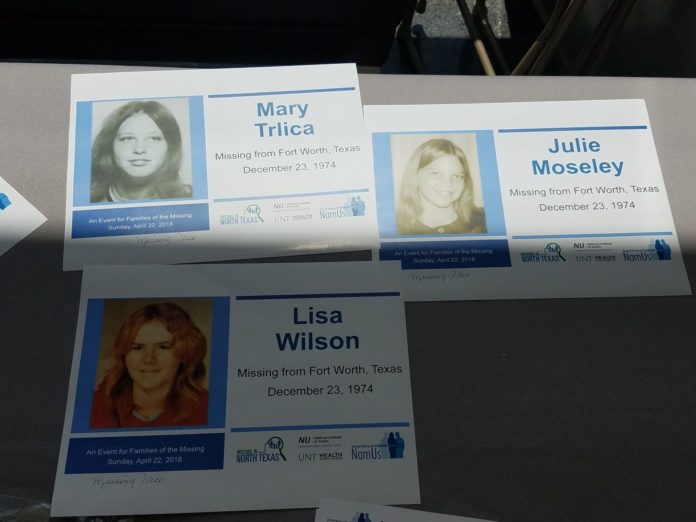Maybe I’m getting soft in my middle age. I did all the typical reporter stuff, knocking on the doors of people whose loved ones had been injured or killed, sometime early in the a.m.
I hated it and did the “flower bed vomit” (as a fellow reporter called it) a couple of times after I’d talked to some grieving, red-eyed, distraught family member.
So, when I found myself at a Missing in Texas event on April 22, I didn’t expect to get caught up in the emotional wave of the event.
“My mother was 21 years of age when she became missing, disappearing from the face of the earth,” said Ariana Lee, 24, daughter of Felecia Johnson, who went missing in 1994. “I was only 3 months old when my mom came up missing. Twenty-four years later … and we’re still here today with no answers and no leads on my mother.”
I can tell you this. Felecia would have been proud of her daughter, standing up in front of a crowd and pouring out her heart to strangers.
Also opening up was Bradley Lawson, father of Brandon Lawson, who went missing five years ago.
“It’s a bad feeling, it’s a horrible feeling. It’s a feeling that you can’t replace in yourself, because something’s been taken away from you that you so badly wanna get back,” he said.
It’s tough to keep any journalistic objectivity when you hear stories like that. Not sure I did and not sure it mattered. Their pain was as evident in the room as the air. More so, as I don’t think about the air.
With funding and oversight from the National Institute of Justice, the University of North Texas Center for Human Identification has since 2011 managed and expanded NamUs, a national information clearinghouse and resource center for missing person cases, unidentified victims, unidentified living individuals and unclaimed bodies. The event was to bring families of the missing together with law enforcement agencies and NamUs to look at ways to expand the search for their loved ones.
All the cases hit close to my heart, but one hit close to home. I met Rusty Arnold, the younger brother of 17-year-old Rachel Trlica, who, just two days before Christmas in 1974, disappeared from the then-Seminary South shopping center in south Fort Worth, along with 14-year-old Renee Wilson and 9-year-old Julie Ann Moseley.
Seminary South was our pre-teen and teenage stomping ground, with a bowling alley, movie theater, bookstore and – perhaps most important – the record store at G. C. Murphy’s.
The young women who disappeared lived a few neighborhoods away from where I grew up, but my parents and grandparents had friends who knew their families. Fort Worth was smaller then, with about half the population it has now.
Their disappearance was one of those events that had people locking their doors, buying big dogs and putting guns next to their beds.
Adding to the mystery, the morning after the disappearance, a letter, allegedly from Rachel Trlica, said that the girls had gone to Houston and would return in a week. Rusty Arnold believes the letter was mailed in or near Throckmorton, Texas, because of the postmark. Some family members don’t believe any of the missing girls wrote the letter.
Now, nearly 44 years later, Arnold continues to seek answers. He maintains a website, missingtrio.com, and a Facebook page seeking information on the case.
And, as the Golden State Killer case demonstrates, new technologies could solve cases like that of the Missing Trio, Lawson and Johnson.
The families are hoping that new legislation passed in other states might be also be passed in Texas to help identify more missing persons.
The legislation would expand the process for comparing missing person reports with unidentified remains kept by a variety of state and local agencies around the country. Those agencies are not required to input data into NamUs. The legislation would require state and local authorities to report unidentified remains to NamUs.
When efforts to pass federal legislation failed, five states passed laws requiring law enforcement officials to share missing person information on the NamUs database.
Tennessee, New Jersey and Connecticut were the first to pass the laws, followed by New York late last year and Michigan earlier this year.
Arnold sees the legislation as a way to clear many cases like those of his sister.
“I think that would go a long way toward clearing some of these cases,” he said. “Some of these answers may be out there in some coroner’s office.”
Lawson, too, believes the law could help link up some of the missing persons with the John and Jane Does who are put in unmarked graves.
“That is a law we definitely need to strive to get passed,” he said.
Fort Worth is fortunate enough to have the tools to find some of these answers for families like Lawson’s and Johnson’s.
Texas should step up and answer the call like these other states. If you were in that room listening to those family members speak, we’d all be marching on the state capitol tomorrow demanding some action.
The next time I have to knock on someone’s door, I’d like to bring them some answers.
Robert Francis is editor of the Fort Worth Business Press.






